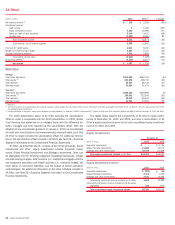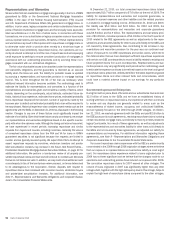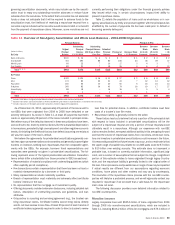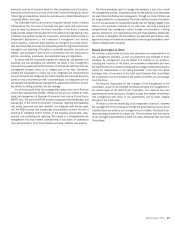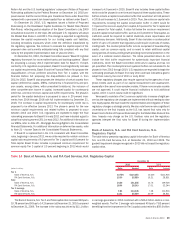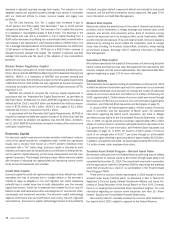Bank of America 2010 Annual Report Download - page 64
Download and view the complete annual report
Please find page 64 of the 2010 Bank of America annual report below. You can navigate through the pages in the report by either clicking on the pages listed below, or by using the keyword search tool below to find specific information within the annual report.FDIC Deposit Insurance Assessments
Since the financial crisis began several years ago, an increasing number of bank
failures has imposed significant costs on the FDIC in resolving those failures,
and the regulator’s deposit insurance fund has been depleted. In order to
maintain a strong funding position and restore reserve ratios of the deposit
insurance fund, the FDIC has increased, and may increase in the future,
assessment rates of insured institutions, including Bank of America.
Deposits placed at the U.S. Banks are insured by the FDIC, subject to
limits and conditions of applicable law and the FDIC’s regulations. Pursuant to
the Financial Reform Act, FDIC insurance coverage limits were permanently
increased to $250,000 per customer. The Financial Reform Act also provides
for unlimited FDIC insurance coverage for non-interest bearing demand de-
posit accounts for a two-year period beginning on December 31, 2010 and
ending on January 1, 2013. The FDIC administers the Deposit Insurance
Fund, and all insured depository institutions are required to pay assessments
to the FDIC that fund the Deposit Insurance Fund. The Financial Reform Act
changed the methodology for calculating deposit insurance assessments
from the amount of an insured depository institution’s domestic deposits to
its total assets minus tangible capital. On February 7, 2011 the FDIC issued a
new regulation implementing revisions to the assessment system mandated
by the Financial Reform Act. The new regulation will be effective April 1, 2011
and will be reflected in the June 30, 2011 FDIC fund balance and the invoices
for assessments due September 30, 2011. As a result of the new regula-
tions, we expect to incur higher annual deposit insurance assessments. We
have identified potential mitigation actions, but they are in the early stages of
development and we are not able to directly control the basis or the amount of
premiums that we are required to pay for FDIC insurance or for other fees or
assessment obligations imposed on financial institutions. Any future in-
creases in required deposit insurance premiums or other bank industry fees
could have a significant adverse impact on our financial condition and results
of operations.
CARD Act
On May 22, 2009, the CARD Act was signed into law. The majority of the CARD
Act provisions became effective in February 2010. The CARD Act legislation
contains comprehensive credit card reform related to credit card industry
practices including significantly restricting banks’ ability to change interest
rates and assess fees to reflect individual consumer risk, changing the way
payments are applied and requiring changes to consumer credit card disclo-
sures. The provisions of the CARD Act negatively impacted net interest income
and card income during 2010, and are expected to negatively impact future
net interest income due to the restrictions on our ability to reprice credit cards
based on risk, and card income due to restrictions imposed on certain fees.
The 2010 full-year decrease in revenue was approximately $1.5 billion.
Regulation E
On November 12, 2009, the Federal Reserve issued amendments to Regula-
tion E which implements the Electronic Fund Transfer Act. The rules became
effective on July 1, 2010 for new customers and August 16, 2010 for existing
customers. These amendments limit the way we and other banks charge an
overdraft fee for non-recurring debit card transactions that overdraw a consum-
er’s account unless the consumer affirmatively consents to the bank’s payment
of overdrafts for those transactions. Under previously announced plans, we do
not offer customers the opportunity to opt-in to overdraft services related to non-
recurring debit card transactions. However, customers are able to opt-in on a
withdrawal-by-withdrawal basis to access cash through the Bank of America ATM
network where the bank is able to alert customers that the transaction may
overdraw their account and result in a fee if they choose to proceed. The impact
of Regulation E, which was in effect beginning in the third quarter and fully in
effect in the fourth quarter of 2010, and our overdraft policy changes, which
were in effect for the full year of 2010, was a reduction in service charges during
2010 of approximately $1.7 billion. In 2011, the incremental reduction to
service charges related to Regulation E and overdraft policy changes is expected
to be approximately $1.1 billion, or a full-year impact of approximately $2.8 bil-
lion, net of identified mitigation action.
U.K. Corporate Income Tax Rate
On July 27, 2010, the U.K. government enacted a law change reducing the
corporate income tax rate by one percent effective for the 2011 U.K. tax
financial year beginning on April 1, 2011. While this rate reduction favorably
affects income tax expense on future U.K. earnings, it also required us to
remeasure our U.K. net deferred tax assets using the lower tax rate, which
resulted in a charge to income tax expense of $392 million in 2010. A future
rate reduction of one percent per year is generally expected to be enacted in
each of 2011, 2012 and 2013, which would result in a similar charge to
income tax expense of nearly $400 million during each of the three years. The
U.K. Treasury has asked for taxpayer views on whether the U.K. government
should alternatively enact the full remaining three-percent reduction entirely
during 2011, which would accelerate the possible charges into 2011 for a
total of approximately $1.1 billion.
Final Regulatory Guidance on Consolidation
On January 21, 2010, the Federal Reserve, Office of the Comptroller of the
Currency, FDIC and Office of Thrift Supervision (collectively, joint agencies)
issued a final rule regarding risk-based capital requirements related to the
impact of the adoption of new consolidation guidance. The impact on the
Corporation on January 1, 2010 due to the new consolidation guidance and
the final rule was an increase in risk-weighted assets of $21.3 billion and a
reduction in capital of $9.7 billion. The overall impact of the new consolidation
guidance and the final rule was a decrease in Tier 1 capital and Tier 1 common
ratios of 76 bps and 73 bps. For more information, see Balance Sheet
Overview – Impact of Adopting New Consolidation Guidance on page 33,
Capital Management beginning on page 67 and Liquidity Risk beginning on
page 71.
Payment Protection Insurance
In the U.K., the Corporation sells PPI through its Global Card Services busi-
ness to credit card customers and has previously sold this insurance to
consumer loan customers. In response to an elevated level of customer
complaints of misleading sales tactics across the industry, heightened media
coverage and pressure from consumer advocacy groups, the U.K. Financial
Services Authority (FSA) has investigated and raised concerns about the way
some companies have handled complaints relating to the sale of these
insurance policies. In August 2010, the FSA issued a policy statement on
the assessment and remediation of PPI claims which is applicable to the
Corporation’s U.K. consumer businesses and is intended to address con-
cerns among consumers and regulators regarding the handling of PPI com-
plaints across the industry. The policy statement sets standards for the sale
of PPI that apply to current and prior sales, and in the event a company does
not or did not comply with the standards, it is alleged that the insurance was
incorrectly sold, giving the customer rights to remedies. Given the new
regulatory guidance, in 2010, the Corporation had a liability of $630 million
based on its current claims history and an estimate of future claims that have
yet to be asserted against the Corporation. For additional information on PPI,
see Note 14 – Commitments and Contingencies to the Consolidated Financial
Statements – Payment Protection Insurance Claims Matter on page 200.
U.K. Bank Levy
On June 22, 2010, the U.K. government announced that it intended to
introduce an annual bank levy. Beginning in 2011, the bank levy will be payable
62 Bank of America 2010




